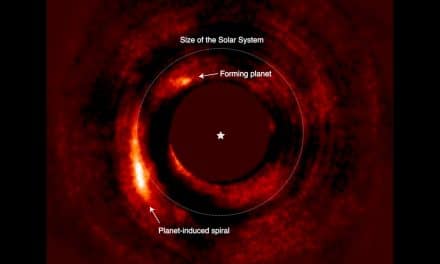Looking back in time at the early universe, astronomers have discovered a cluster of galaxies merging together around a rare red quasar within a massive black hole
The findings by Johns Hopkins University and an international team using the James Webb Space Telescope offer an unprecedented opportunity to observe how billions of years ago galaxies coalesced into the modern universe.
Co-author Andrey Vayner is a Johns Hopkins postdoctoral fellow who studies the evolution of galaxies. He said: “We think something dramatic is about to happen in these systems.
“The galaxy is at this perfect moment in its lifetime, about to transform and look entirely different in a few billion years.”
The James Webb Space Telescope, launched last December by NASA, the European Space Agency, and the Canadian Space Agency, is the largest, most powerful telescope ever sent into space.
See also: Black hole spews out material years after shredding star
multiple galaxies
Its initial general observations were revealed in July, but this quasar imagery is one of just 13 ‘early look’ projects selected through a highly competitive global competition to decide where the telescope is pointed during its first months of operation.
Although earlier observations of this area by NASA/ ESA Hubble Space Telescope and the Near-Infrared Integral Field Spectrometer instrument on the Gemini-North telescope pinpointed the quasar and hinted at the possibility of a galaxy in transition, no one suspected that with Webb’s crisp imaging they’d see multiple galaxies, at least three, swirling the region.
Nadia L Zakamska is a Johns Hopkins astrophysicist and co-principal investigator. She said: “With previous images we thought we saw hints that the galaxy was possibly interacting with other galaxies on the path to merger because their shapes get distorted in the process and we thought we maybe saw that.
“But after we got the Webb data, I was like, ‘I have no idea what we’re even looking at here, what is all this stuff?’ We spent several weeks just staring and staring at these images.”
The Webb revealed at least three galaxies moving incredibly fast, suggesting a large amount of mass is present.
The team believes this could be one of the densest known areas of galaxy formation in the early universe.
the universe’s evolution
Zamaska added: “Because light takes time to travel to us, when we look at objects like this one in the very distant regions of the universe, we’re seeing light that was emitted about 11.5 billion years ago, or from the earliest stages of the universe’s evolution.
“Massive galaxy swarms like this one were likely common then.”
Even Vayner, who’d dreamed of using Webb data since he first heard about the telescope as an undergraduate more than a decade ago, and thought he knew what to expect, was shocked to see his long-studied spot in the universe revealed with such clarity.
He said: “It really will transform our understanding of this object.”
The blindingly bright quasar, fuelled by what Zakamska calls a “monster” black hole at the centre of the galactic swirl, is a rare “extremely red” quasar, about 11.5 billion years old and one of the most powerful ever seen from such distance.
It’s essentially a black hole in formation, Vayner said, eating the gas around it and growing in mass. The clouds of dust and gas between Earth and the glowing gas near the black hole make the quasar appear red.
baby galaxy
The team is already working on follow-up observations into this unexpected galaxy cluster, hoping to better understand how dense, chaotic galaxy clusters form, and how it is affected by the supermassive black hole at its heart.
“What you see here is only a small subset of what’s in the data set,” Zakamska said.
“There’s just too much going on here, so we first highlighted what really is the biggest surprise.
“Every blob here is a baby galaxy merging into this mommy galaxy and the colours are different velocities and the whole thing is moving in an extremely complicated way.
“We can now start to untangle the motions.”
The research appears in Astrophysical Journal Letters.
Image: A Hubble image of the quasar and the same area viewed with the James Webb Space Telescope. The Webb image shows multiple galaxies coalescing, with each colour representing a different velocity: Red is moving away from us. Blue is moving toward us.
Credit: ESA/ Webb, NASA & CSA, D Wylezalek, A Vayner & the Q3D Team, N Zakamska.












